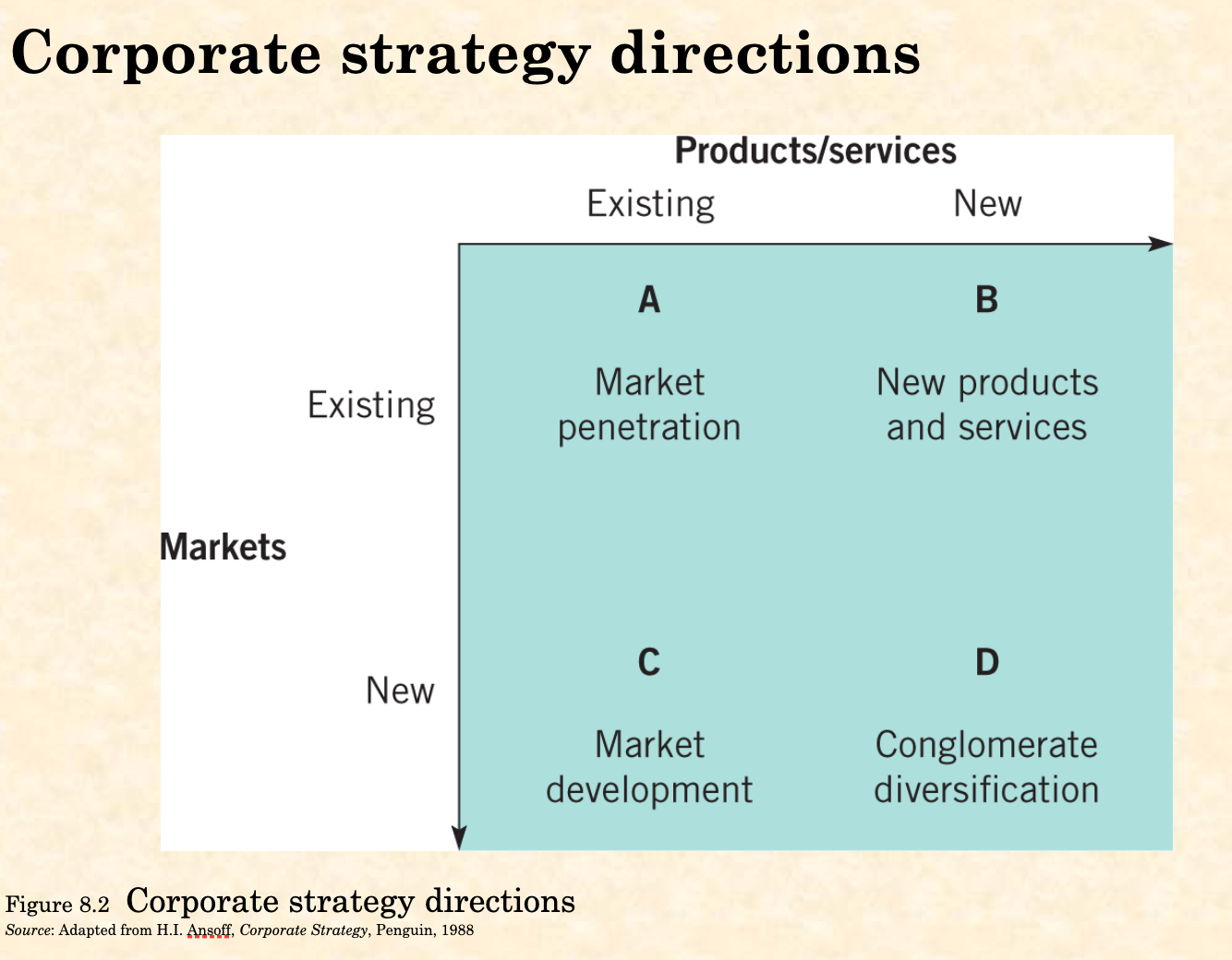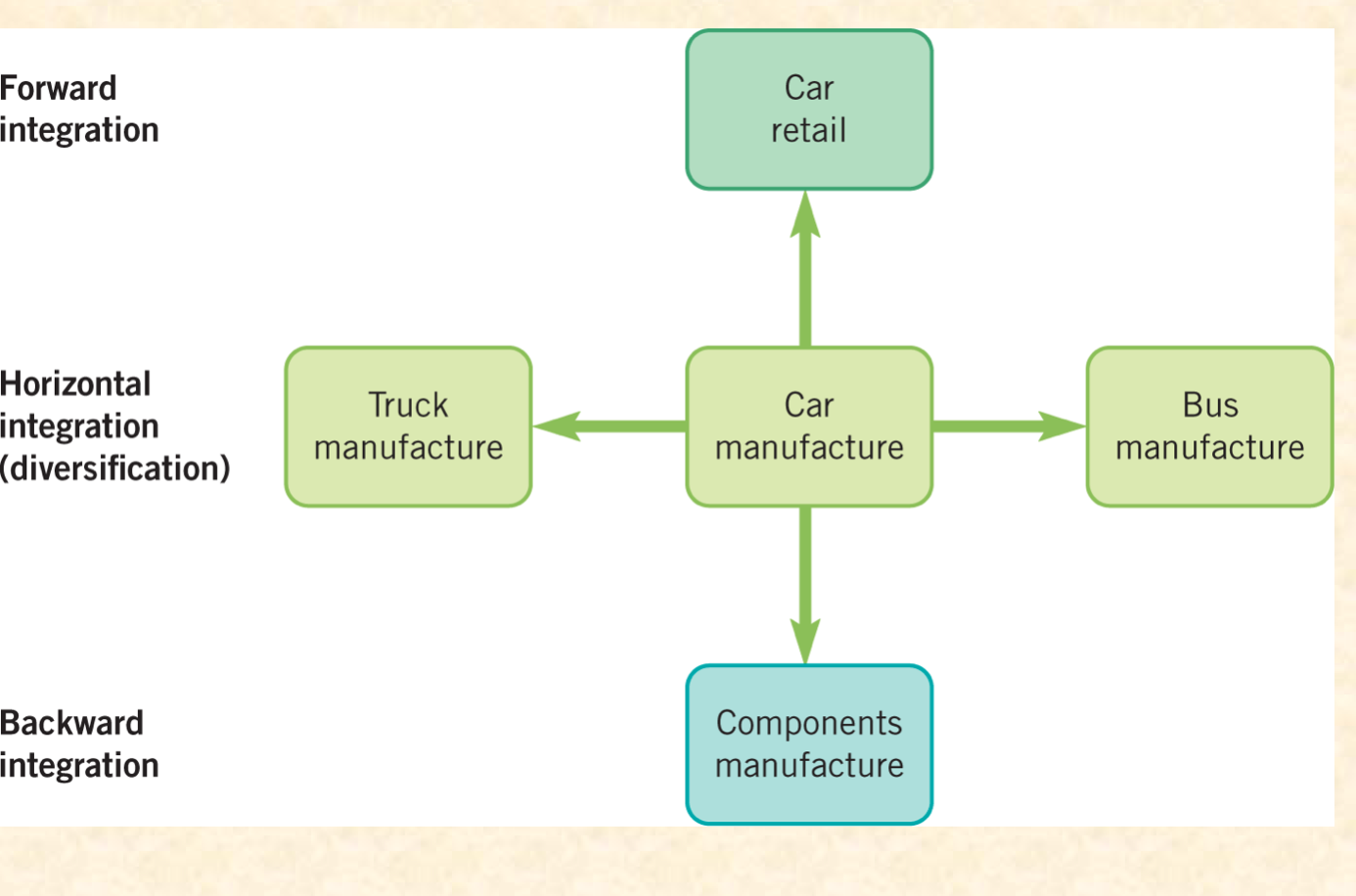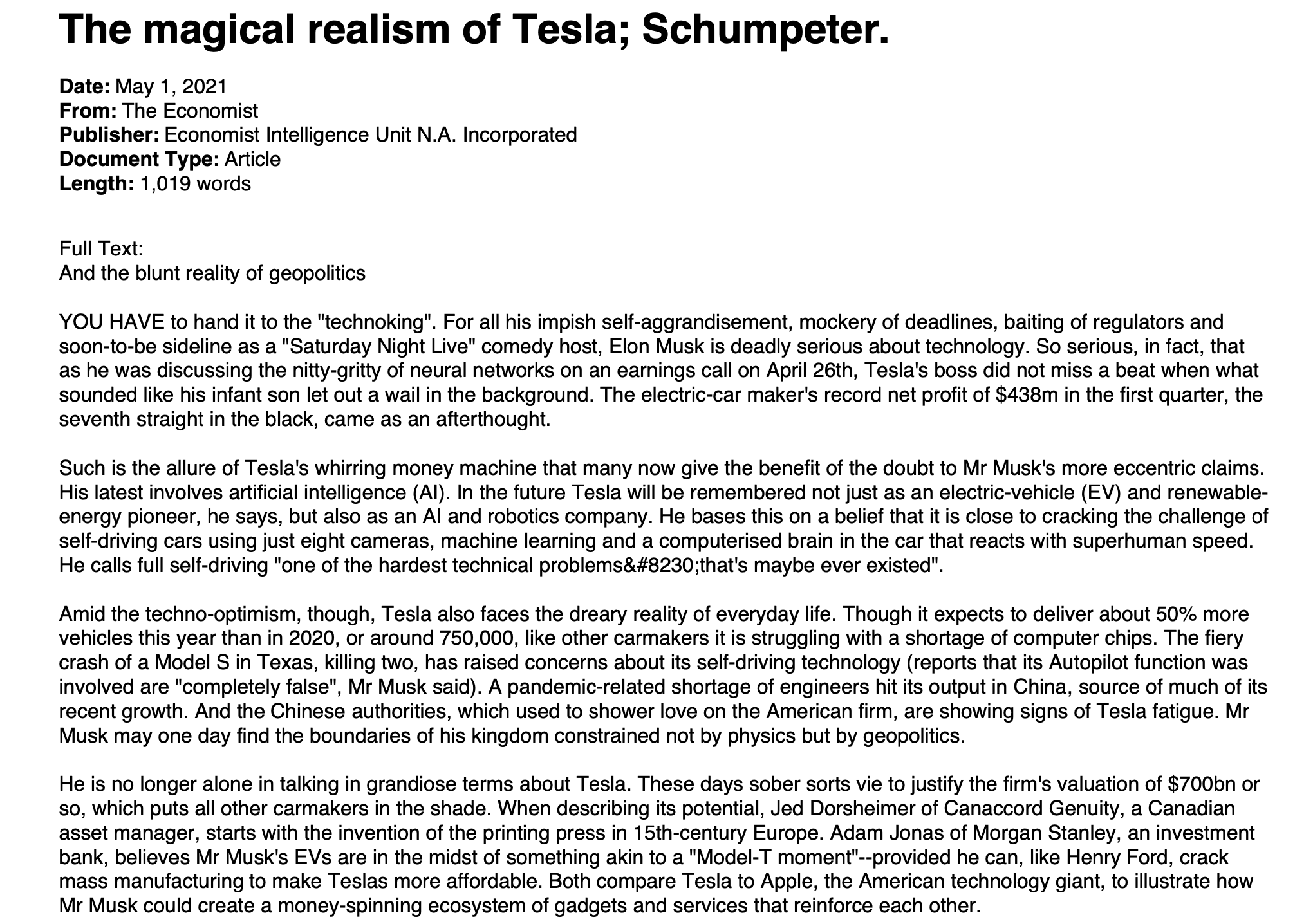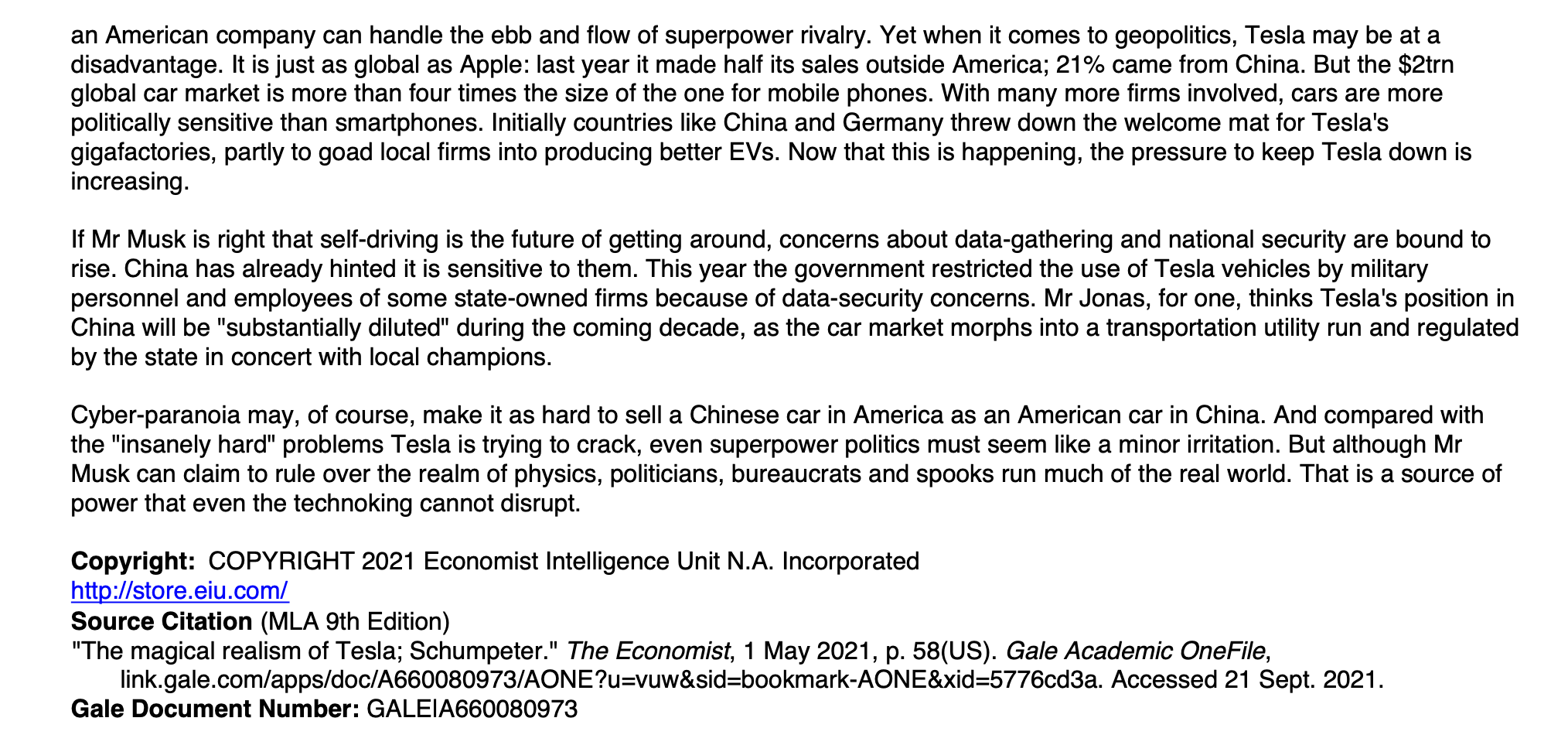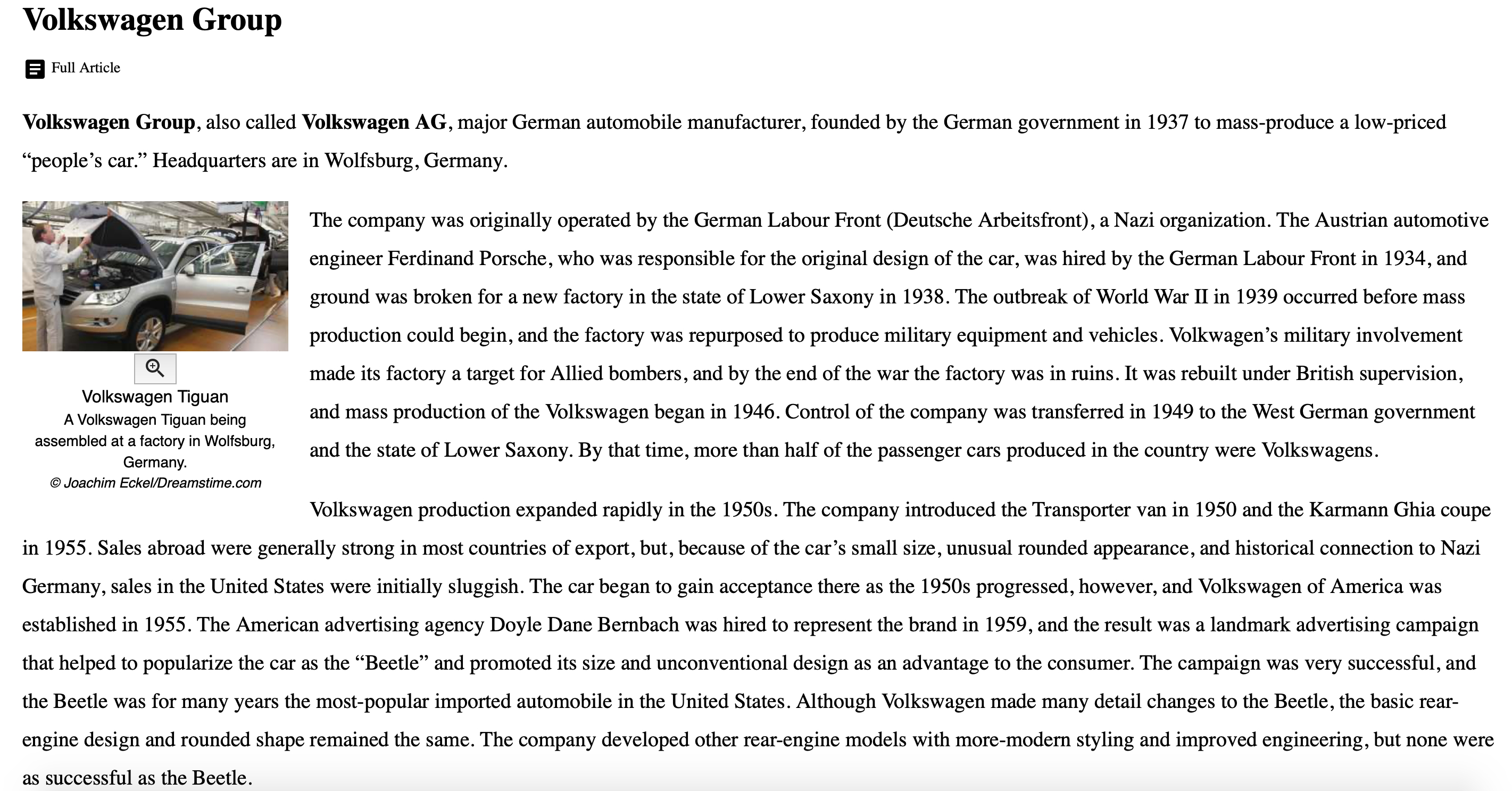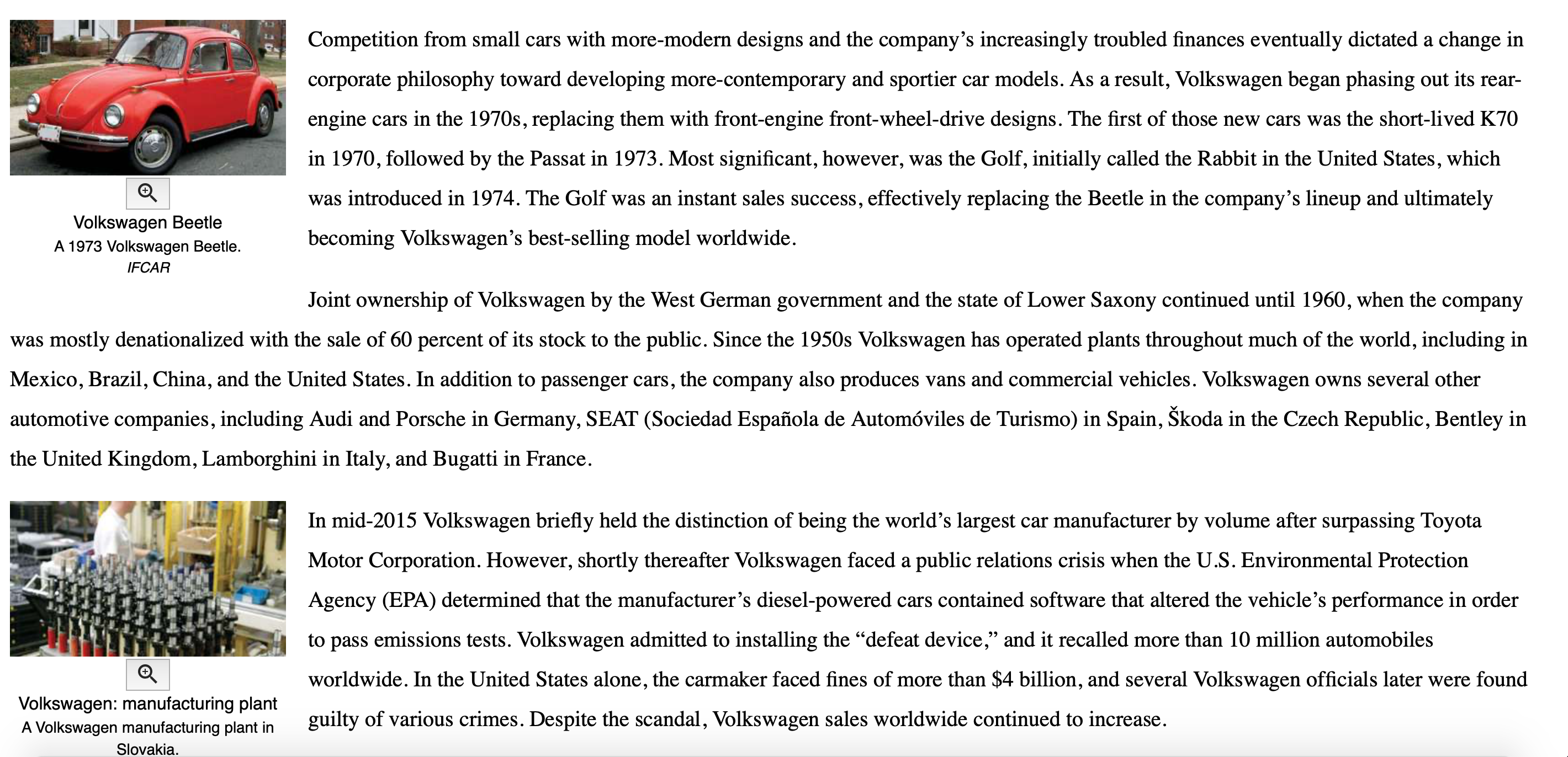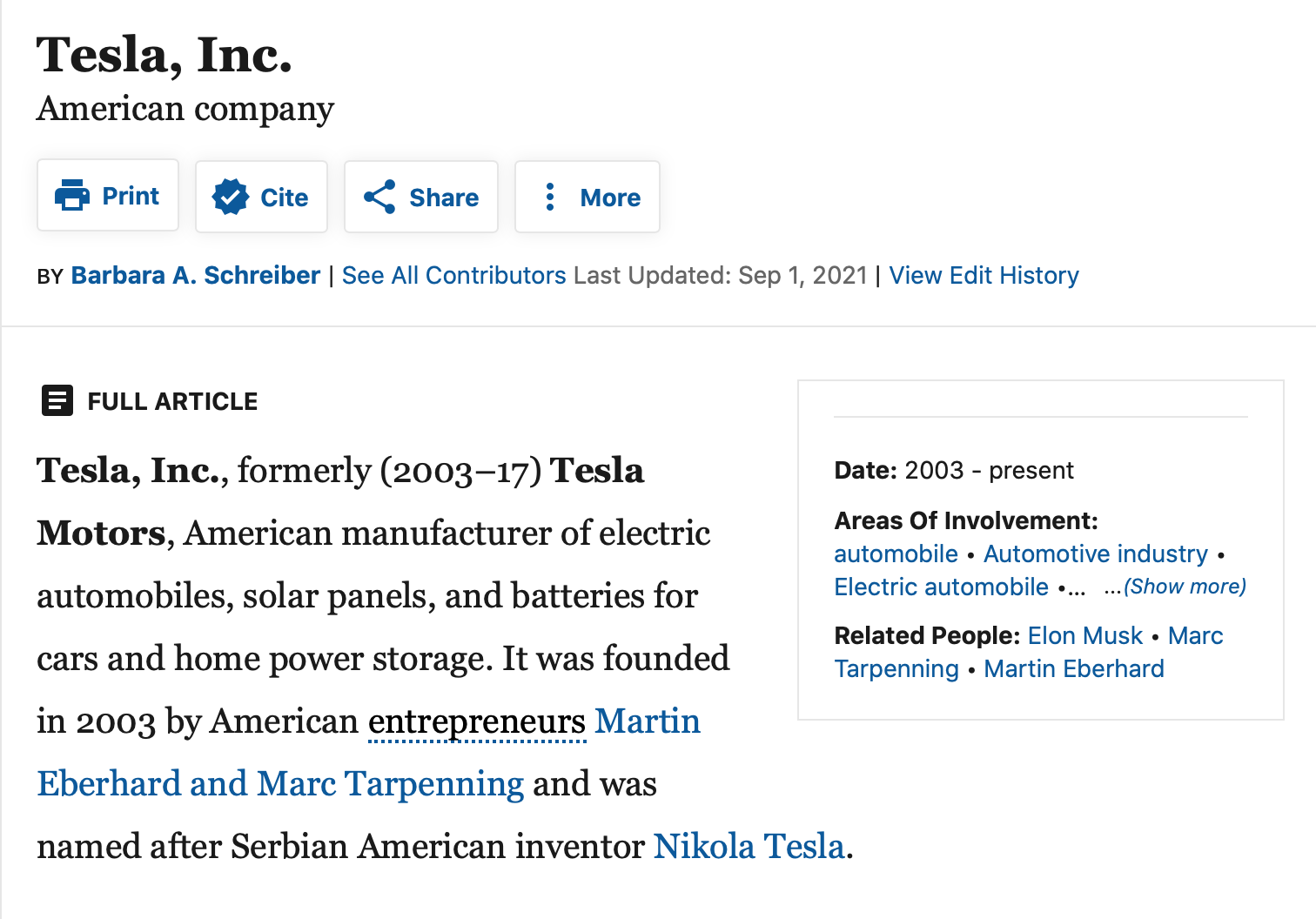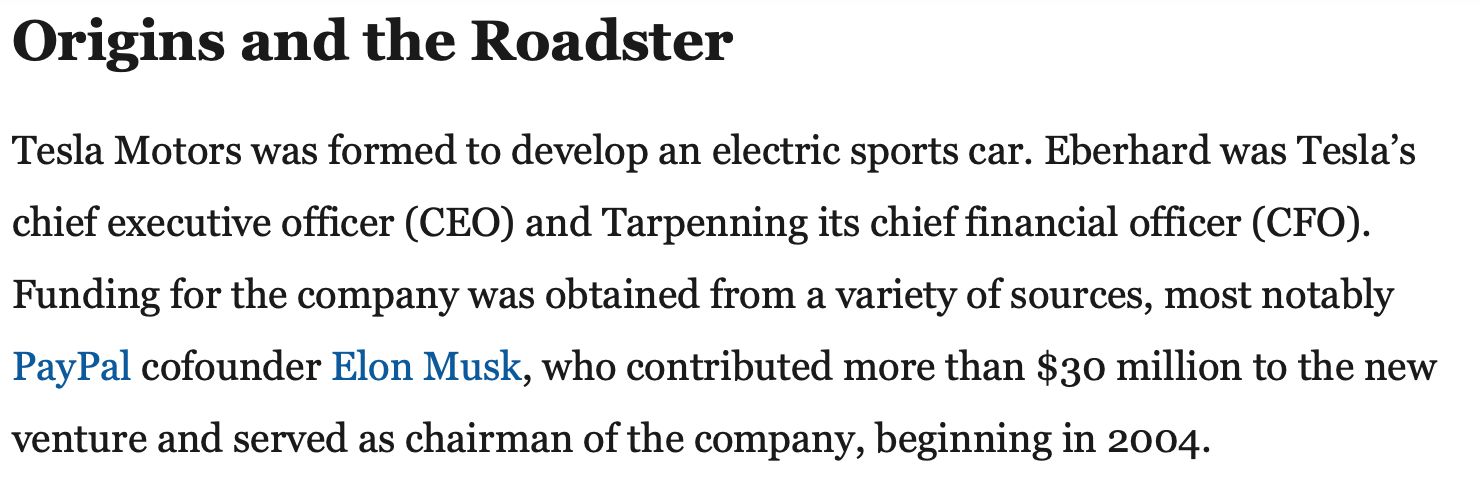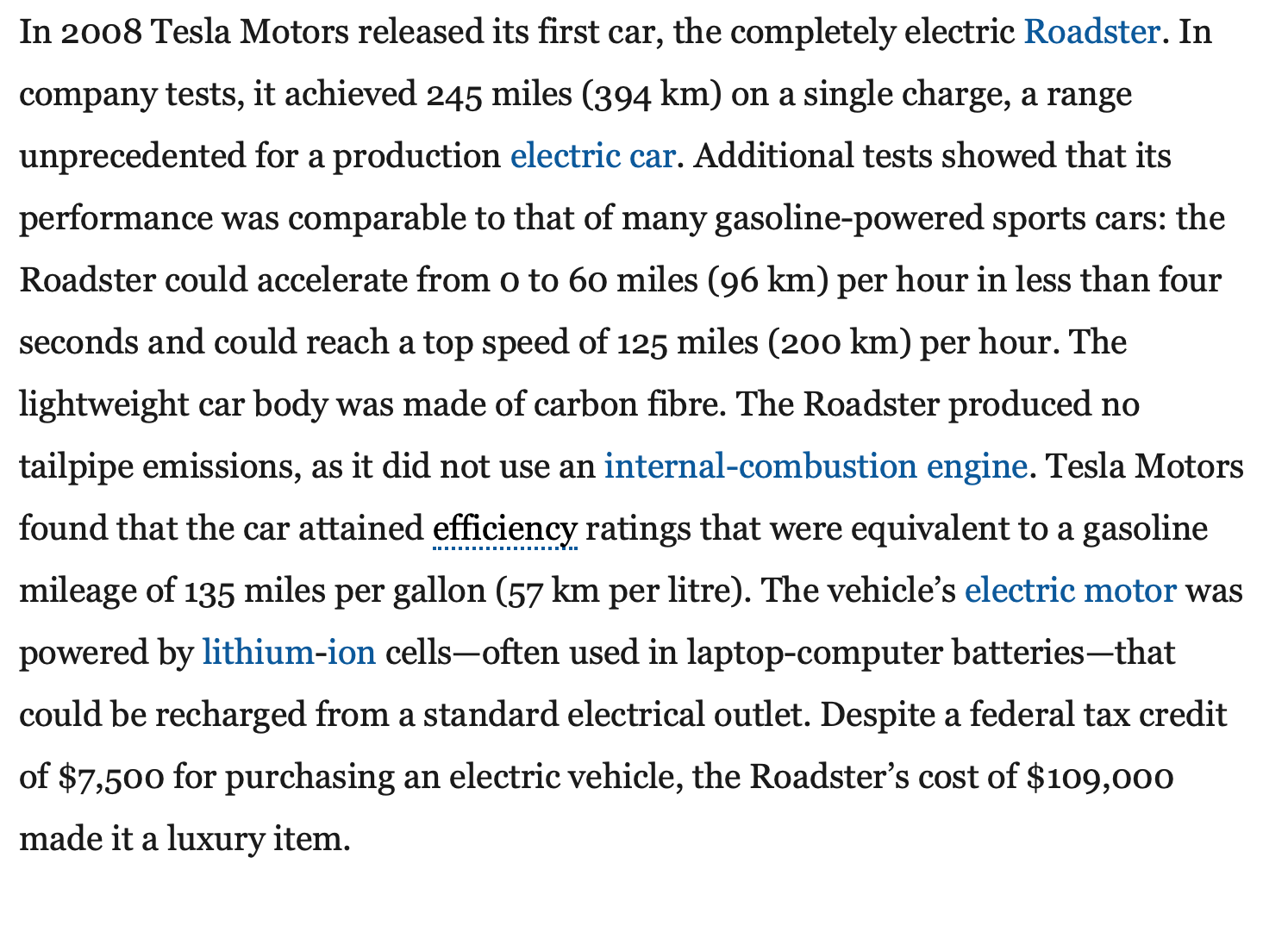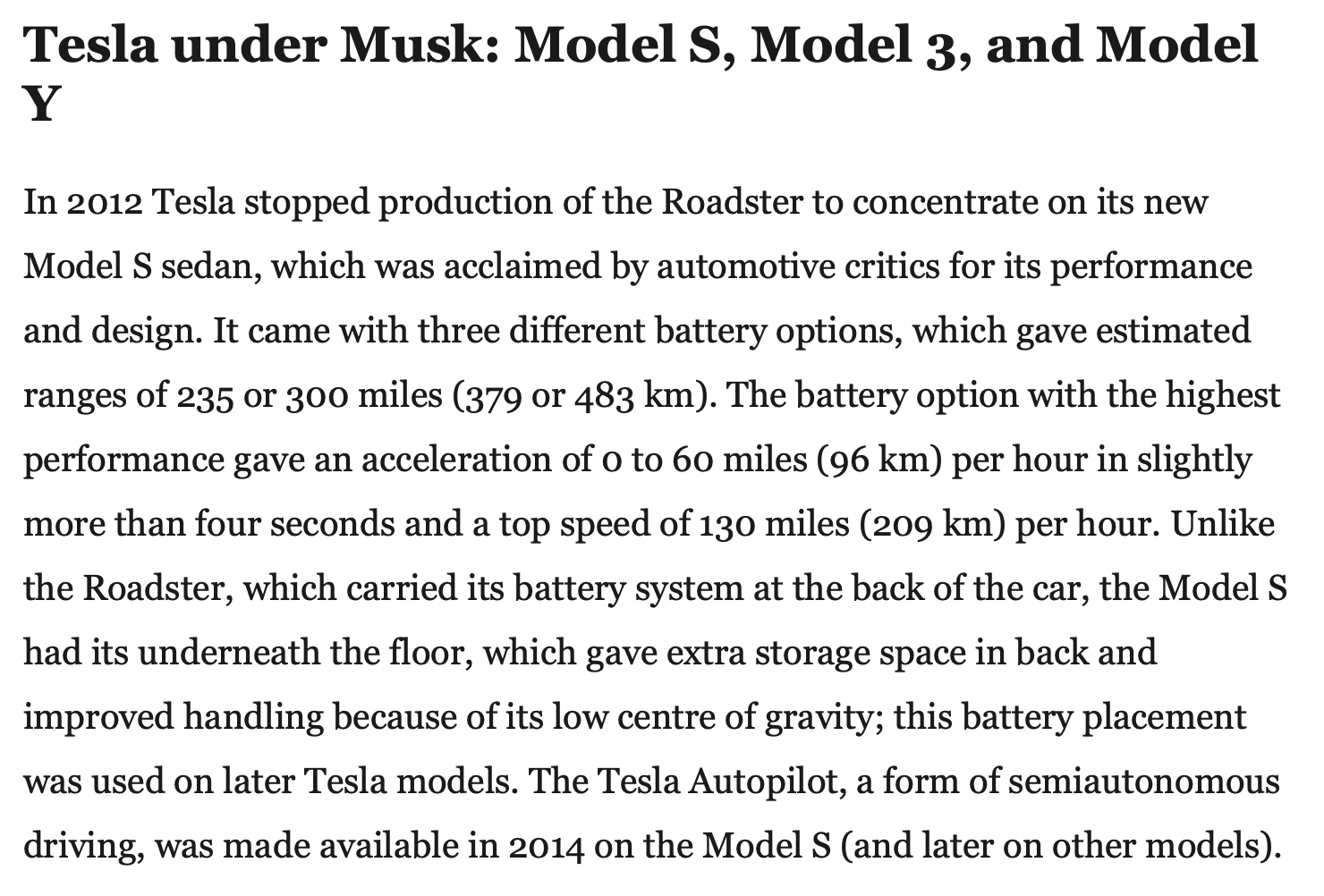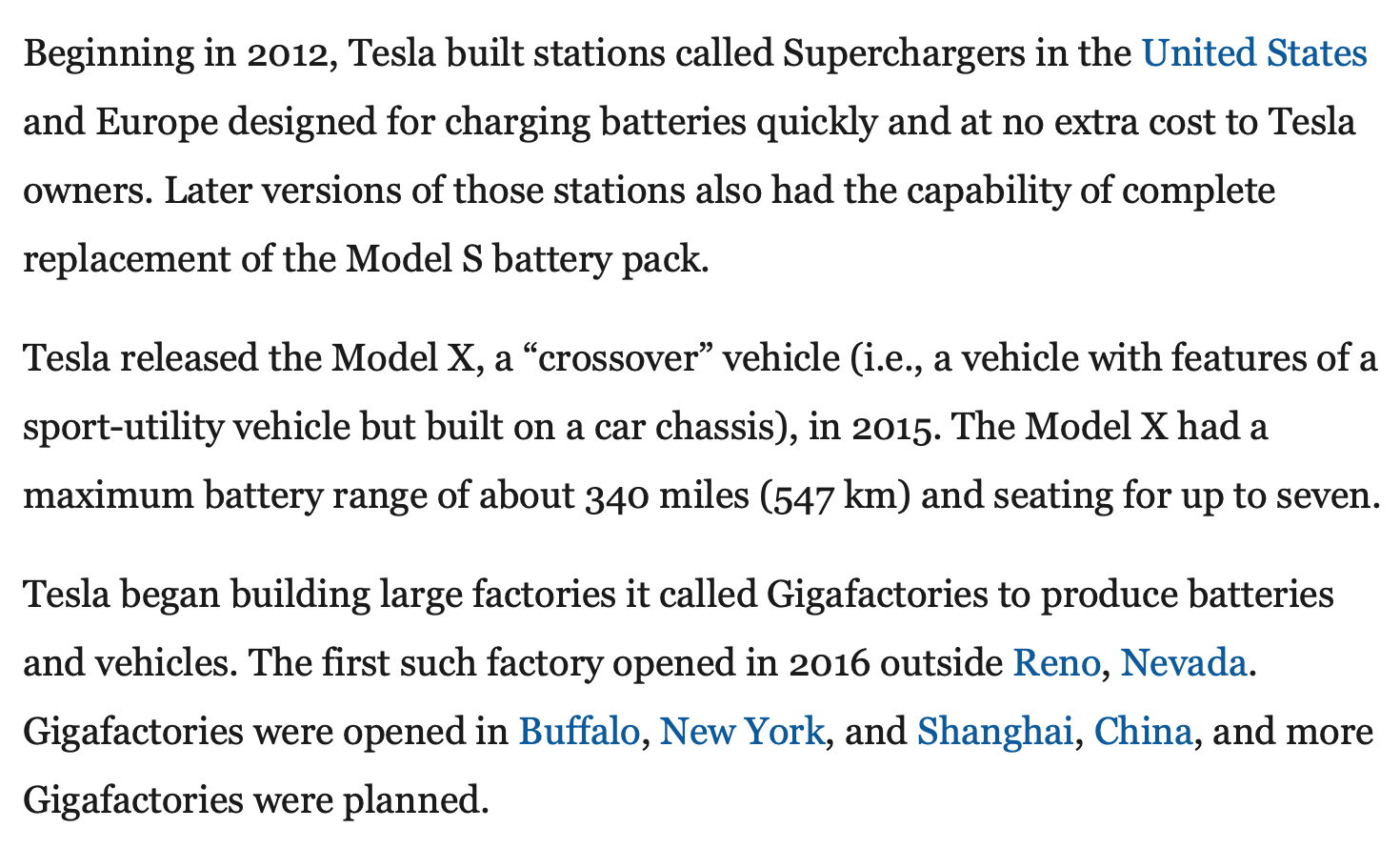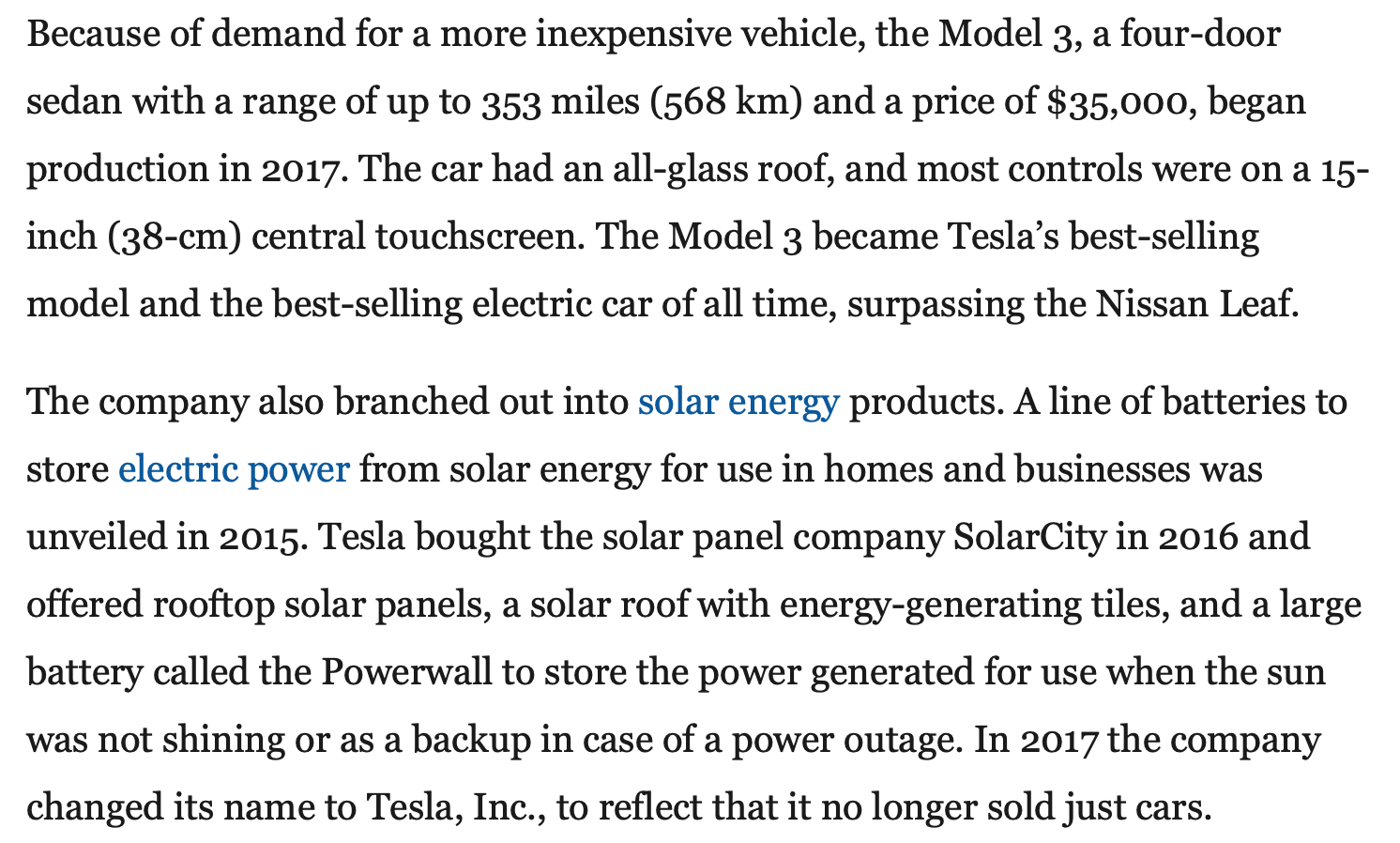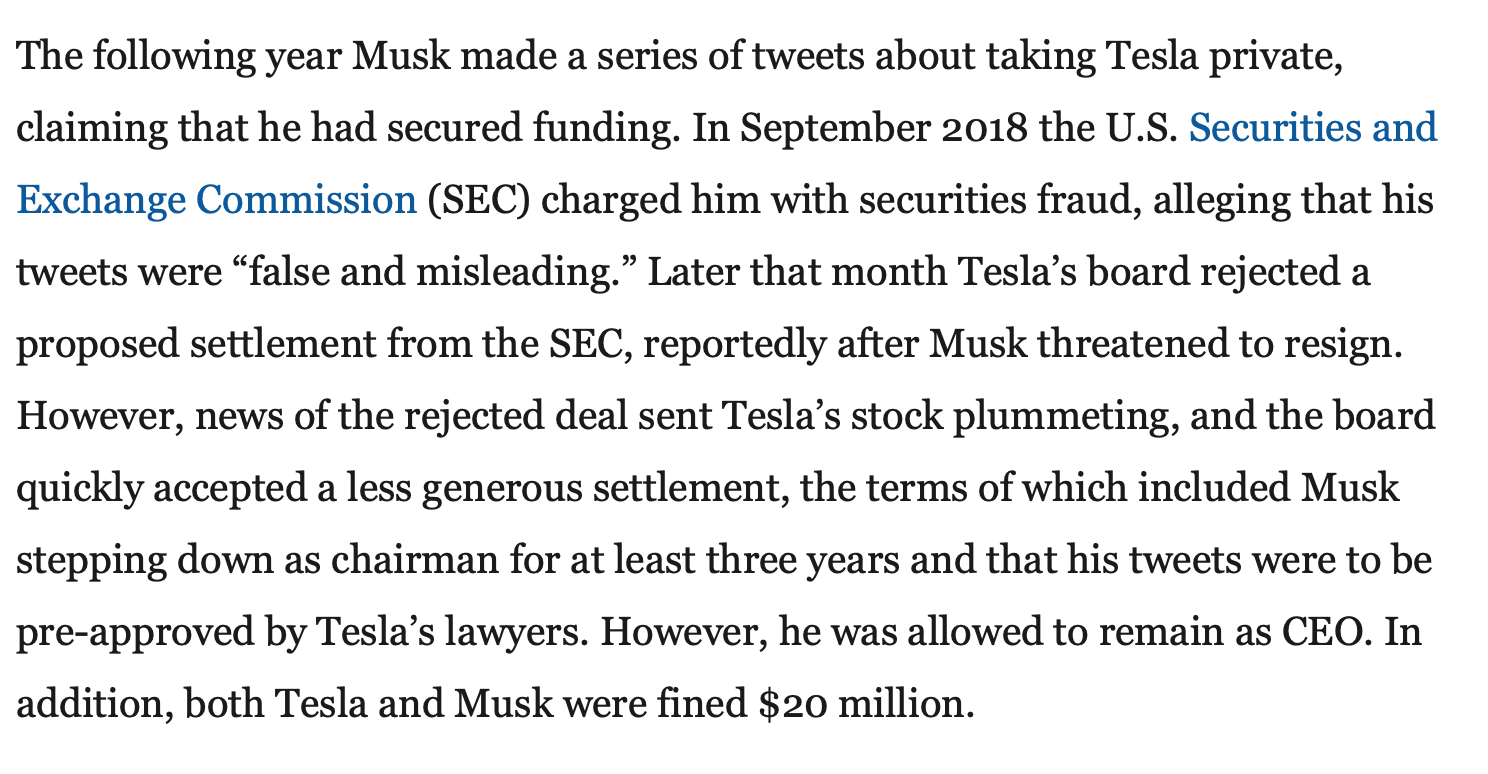- The strategic choices made by organizations often pertain to organizational scope and diversification.
- -Use Ansoff's framework on Corporate Strategy Directions (Figure 8.2) to identify, briefly discuss, and compare the directions that have been relevant to the diversification of the corporations Volkswagen Group and Tesla Inc. You can include examples from their past and any corporate diversification they are currently planning for the future.
- -Identify, briefly discuss, and compare any changes in vertical and horizontal integration that each firm has undertaken in thegeneral vehicle industry(Figure 8.4) - i.e. including, but not only Electric Vehicles.
- -Use your analysis to conclude with a recommendation for each organization on action it should take with regards to its scope and diversification.
- The strategic choices made by organizations often pertain to organizational scope and diversification.
- -Use Ansoff's framework on Corporate Strategy Directions (Figure 8.2) to identify, briefly discuss, and compare the directions that have been relevant to the diversification of the corporations Volkswagen Group and Tesla Inc. You can include examples from their past and any corporate diversification they are currently planning for the future.
- -Identify, briefly discuss, and compare any changes in vertical and horizontal integration that each firm has undertaken in thegeneral vehicle industry(Figure 8.4) - i.e. including, but not only Electric Vehicles.
- -Use your analysis to conclude with a recommendation for each organization on action it should take with regards to its scope and diversification.
Corporate strategy directions Products/services Existing New Existing Markets New Figure 3.2 Corporate strategy directions Source: Adapted from H.I. Mani, Corporate Strategy, Penguin, 1988 Forward Car integration retail Horizontal integration Truck Car Bus (diversification) manufacture manufacture manufacture Backward Components integration manufactureThe magical realism of Tesla; Schumpeter. Date: May 1, 2021 From: The Economist Publisher: Economist Intelligence Unit N.A. Incorporated Document Type: Article Length: 1,019 words Full Text: And the blunt reality of geopolitics YOU HAVE to hand it to the "technoking". For all his impish self-aggrandisement, mockery of deadlines, baiting of regulators and soon-to-be sideline as a "Saturday Night Live" comedy host, Elon Musk is deadly serious about technology. So serious, in fact, that as he was discussing the nitty-gritty of neural networks on an earnings call on April 26th, Tesla's boss did not miss a beat when what sounded like his infant son let out a wail in the background. The electric-car maker's record net profit of $438m in the first quarter, the seventh straight in the black, came as an afterthought. Such is the allure of Tesla's whirring money machine that many now give the benefit of the doubt to Mr Musk's more eccentric claims. His latest involves artificial intelligence (Al). In the future Tesla will be remembered not just as an electric-vehicle (EV) and renewable- energy pioneer, he says, but also as an Al and robotics company. He bases this on a belief that it is close to cracking the challenge of self-driving cars using just eight cameras, machine learning and a computerised brain in the car that reacts with superhuman speed. He calls full self-driving "one of the hardest technical problems…that's maybe ever existed". Amid the techno-optimism, though, Tesla also faces the dreary reality of everyday life. Though it expects to deliver about 50% more vehicles this year than in 2020, or around 750,000, like other carmakers it is struggling with a shortage of computer chips. The fiery crash of a Model S in Texas, killing two, has raised concerns about its self-driving technology (reports that its Autopilot function was involved are "completely false", Mr Musk said). A pandemic-related shortage of engineers hit its output in China, source of much of its recent growth. And the Chinese authorities, which used to shower love on the American firm, are showing signs of Tesla fatigue. Mr Musk may one day find the boundaries of his kingdom constrained not by physics but by geopolitics. He is no longer alone in talking in grandiose terms about Tesla. These days sober sorts vie to justify the firm's valuation of $700bn or so, which puts all other carmakers in the shade. When describing its potential, Jed Dorsheimer of Canaccord Genuity, a Canadian asset manager, starts with the invention of the printing press in 15th-century Europe. Adam Jonas of Morgan Stanley, an investment bank, believes Mr Musk's EVs are in the midst of something akin to a "Model-T moment"--provided he can, like Henry Ford, crack mass manufacturing to make Teslas more affordable. Both compare Tesla to Apple, the American technology giant, to illustrate how Mr Musk could create a money-spinning ecosystem of gadgets and services that reinforce each other.For Tesla bulls, the maker of EVs indeed has more in common with that of iPhones than it does with established car firms. Its boosters get excited about Silicon Valley-like innovation, not car sales. On Wall Street the value ascribed to Tesla's relatively low- margin EV business is being eclipsed by the promise of more nebulous but potentially more lucrative ones, mostly involving software: the sort of connected services, such as maps, entertainment, ride-sharing, semi-autonomous driving and over-the-air upgrades that make Teslas a geek's dream. Few assume, as Mr Musk does, that fully autonomous "robotaxis" are imminent. But some, such as Mr Jonas, think Tesla ride-sharing fleets, probably with someone at the wheel, will soon be rolling through city streets. The magical realism may go beyond that. Besides Al and software, Mr Musk is also doubling down on Tesla's original plan to build, alongside an affordable car, a zero-emission energy business. He has said his intention is to produce three terawatt-hours of battery capacity within a decade, more than 12 times as much as the goal of Volkswagen, its nearest EV competitor. Besides bringing the cost of cars down to $25,000 each, the batteries will also go towards Tesla's home-energy-storage business. That would create what he calls a "giant distributed utility" that can cope with increased electricity demand as more people use EVs, as well as provide grid stability at times of bad weather. Mr Dorsheimer, who is particularly bullish on Tesla's solar and storage business, thinks its energy brand could become "Apple-esque". Thinking different Apple, worth more than three times as much as Tesla, is a flattering firm to be compared to. It is also the prime example of how deftly an American company can handle the ebb and flow of superpower rivalry. Yet when it comes to geopolitics, Tesla may be at a disadvantage. It is just as global as Apple: last year it made half its sales outside America; 21% came from China. But the $2trn global car market is more than four times the size of the one for mobile phones. With many more firms involved, cars are more politically sensitive than smartphones. Initially countries like China and Germany threw down the welcome mat for Tesla's gigafactories, partly to goad local firms into producing better EVs. Now that this is happening, the pressure to keep Tesla down is increasing. If Mr Musk is right that self-driving is the future of getting around, concerns about data-gathering and national security are bound to rise. China has already hinted it is sensitive to them. This year the government restricted the use of Tesla vehicles by military personnel and employees of some state-owned firms because of data-security concerns. Mr Jonas, for one, thinks Tesla's position in China will be "substantially diluted" during the coming decade, as the car market morphs into a transportation utility run and regulated by the state in concert with local champions. Cyber-paranoia may, of course, make it as hard to sell a Chinese car in America as an American car in China. And compared with the "insanely hard" problems Tesla is trying to crack, even superpower politics must seem like a minor irritation. But although Mr Musk can claim to rule over the realm of physics, politicians, bureaucrats and spooks run much of the real world. That is a source of power that even the technoking cannot disrupt. Copyright: COPYRIGHT 2021 Economist Intelligence Unit N.A. Incorporated http://store.eiu.com/ Source Citation (MLA 9th Edition) "The magical realism of Tesla; Schumpeter." The Economist, 1 May 2021, p. 58(US). Gale Academic OneFile, link.gale.com/apps/doc/A660080973/AONE?u=vuw&sid=bookmark-AONE&xid=5776cd3a. Accessed 21 Sept. 2021. Gale Document Number: GALEIA660080973Volkswagen Group Full Article Volkswagen Group, also called Volkswagen AG, major German automobile manufacturer, founded by the German government in 1937 to mass-produce a low-priced "people's car." Headquarters are in Wolfsburg, Germany. The company was originally operated by the German Labour Front (Deutsche Arbeitsfront), a Nazi organization. The Austrian automotive engineer Ferdinand Porsche, who was responsible for the original design of the car, was hired by the German Labour Front in 1934, and ground was broken for a new factory in the state of Lower Saxony in 1938. The outbreak of World War II in 1939 occurred before mass production could begin, and the factory was repurposed to produce military equipment and vehicles. Volkwagen's military involvement made its factory a target for Allied bombers, and by the end of the war the factory was in ruins. It was rebuilt under British supervision, Volkswagen Tiguan A Volkswagen Tiguan being and mass production of the Volkswagen began in 1946. Control of the company was transferred in 1949 to the West German government assembled at a factory in Wolfsburg, Germany. and the state of Lower Saxony. By that time, more than half of the passenger cars produced in the country were Volkswagens. Joachim Eckel/Dreamstime.com Volkswagen production expanded rapidly in the 1950s. The company introduced the Transporter van in 1950 and the Karmann Ghia coupe in 1955. Sales abroad were generally strong in most countries of export, but, because of the car's small size, unusual rounded appearance, and historical connection to Nazi Germany, sales in the United States were initially sluggish. The car began to gain acceptance there as the 1950s progressed, however, and Volkswagen of America was established in 1955. The American advertising agency Doyle Dane Bernbach was hired to represent the brand in 1959, and the result was a landmark advertising campaign that helped to popularize the car as the "Beetle" and promoted its size and unconventional design as an advantage to the consumer. The campaign was very successful, and the Beetle was for many years the most-popular imported automobile in the United States. Although Volkswagen made many detail changes to the Beetle, the basic rear- engine design and rounded shape remained the same. The company developed other rear-engine models with more-modern styling and improved engineering, but none were as successful as the Beetle.Competition from small cars with more-modern designs and the company's increasingly troubled finances eventually dictated a change in corporate philosophy toward developing more-contemporary and sportier car models. As a result, Volkswagen began phasing out its rear- engine cars in the 1970s, replacing them with front-engine front-wheel-drive designs. The first of those new cars was the short-lived K70 in 1970, followed by the Passat in 1973. Most significant, however, was the Golf, initially called the Rabbit in the United States, which was introduced in 1974. The Golf was an instant sales success, effectively replacing the Beetle in the company's lineup and ultimately Volkswagen Beetle A 1973 Volkswagen Beetle. becoming Volkswagen's best-selling model worldwide. IFCAR Joint ownership of Volkswagen by the West German government and the state of Lower Saxony continued until 1960, when the company was mostly denationalized with the sale of 60 percent of its stock to the public. Since the 1950s Volkswagen has operated plants throughout much of the world, including in Mexico, Brazil, China, and the United States. In addition to passenger cars, the company also produces vans and commercial vehicles. Volkswagen owns several other automotive companies, including Audi and Porsche in Germany, SEAT (Sociedad Espanola de Automoviles de Turismo) in Spain, Skoda in the Czech Republic, Bentley in the United Kingdom, Lamborghini in Italy, and Bugatti in France. In mid-2015 Volkswagen briefly held the distinction of being the world's largest car manufacturer by volume after surpassing Toyota Motor Corporation. However, shortly thereafter Volkswagen faced a public relations crisis when the U.S. Environmental Protection Agency (EPA) determined that the manufacturer's diesel-powered cars contained software that altered the vehicle's performance in order to pass emissions tests. Volkswagen admitted to installing the "defeat device," and it recalled more than 10 million automobiles worldwide. In the United States alone, the carmaker faced fines of more than $4 billion, and several Volkswagen officials later were found Volkswagen: manufacturing plant A Volkswagen manufacturing plant in guilty of various crimes. Despite the scandal, Volkswagen sales worldwide continued to increase. Slovakia.Tesla, Inc. American company Print Cite Share . . . More BY Barbara A. Schreiber | See All Contributors Last Updated: Sep 1, 2021 | View Edit History FULL ARTICLE Tesla, Inc., formerly (2003-17) Tesla Date: 2003 - present Motors, American manufacturer of electric Areas Of Involvement: automobile . Automotive industry . automobiles, solar panels, and batteries for Electric automobile .... ...(Show more) Related People: Elon Musk . Marc cars and home power storage. It was founded Tarpenning . Martin Eberhard in 2003 by American entrepreneurs Martin Eberhard and Marc Tarpenning and was named after Serbian American inventor Nikola Tesla.Origins and the Roadster Tesla Motors was formed to develop an electric sports car. Eberhard was Tesla's chief executive officer (CEO) and Tarpenning its chief financial officer (CFO). Funding for the company was obtained from a variety of sources, most notably PayPal cofounder Elon Musk, who contributed more than $30 million to the new venture and served as chairman of the company, beginning in 2004.In 2008 Tesla Motors released its rst car, the completely electric Roadster. In company tests, it achieved 245 miles (394 km) on a single charge, a range unprecedented for a production electric car. Additional tests showed that its performance was comparable to that of many gasoline-powered sports cars: the Roadster could accelerate from 0 to 60 miles (96 km) per hour in less than four seconds and could reach a top speed of 125 miles (200 km) per hour. The lightweight car body was made of carbon bre. The Roadster produced no tailpipe emissions, as it did not use an internal-combustion engine. Tesla Motors found that the car attained efc1ency ratings that were equivalent to a gasoline mileage of 135 miles per gallon (57 km per litre). The vehicle's electric motor was powered by lithium-ion cellsoften used in laptop-computer batteriesthat could be recharged from a standard electrical outlet. Despite a federal tax credit of $7,500 for purchasing an electric vehicle, the Roadster's cost of $109,000 made it a luxury item. In late 2007 Eberhard resigned as CEO and president of technology and joined the advisory board of the company. It was announced in 2008 that he had left the company, though he remained a shareholder. Tarpenning, who was vice president of electrical engineering, supervising the development of electronic and software systems for the Roadster, also left the company in 2008. Musk took over as CEO. In 2010 Tesla's initial public offering raised some $226 million. Tesla under Musk: Model S, Model 3, and Model Y In 2012 Tesla stopped production of the Roadster to concentrate on its new Model S sedan, which was acclaimed by automotive critics for its performance and design. It came with three different battery options, which gave estimated ranges of 235 or 300 miles (379 or 483 km). The battery option with the highest performance gave an acceleration of 0 to 60 miles (96 km) per hour in slightly more than four seconds and a top speed of 130 miles (209 km) per hour. Unlike the Roadster, which carried its battery system at the back of the car, the Model S had its underneath the oor, which gave extra storage space in back and improved handling because of its low centre of gravity; this battery placement was used on later Tesla models. The Tesla Autopilot, a form of semiautonomous driving, was made available in 2014 on the Model S (and later on other models). Beginning in 2012, Tesla built stations called Superchargers in the United States and Europe designed for charging batteries quickly and at no extra cost to Tesla owners. Later versions of those stations also had the capability of complete replacement of the Model S battery pack. Tesla released the Model X, a \"crossover\" vehicle (i.e., a vehicle with features of a sport-utility vehicle but built on a car chassis), in 2015. The Model X had a maximum battery range of about 340 miles (547 km) and seating for up to seven. Tesla began building large factories it called Gigafactories to produce batteries and vehicles. The rst such factory opened in 2016 outside Reno, Nevada. Gigafactories were opened in Buffalo, New York, and Shanghai, China, and more Gigafactories were planned. Because of demand for a more inexpensive vehicle, the Model 3, a four-door sedan with a range of up to 353 miles (568 km) and a price of $35,000, began production in 2017. The car had an all-glass roof, and most controls were on a 15- inch (38-cm) central touchscreen. The Model 3 became Tesla's best-selling model and the best-selling electric car of all time, surpassing the Nissan Leaf. The company also branched out into solar energy products. A line of batteries to store electric power from solar energy for use in homes and businesses was unveiled in 2015. Tesla bought the solar panel company SolarCity in 2016 and offered rooftop solar panels, a solar roof with energy-generating tiles, and a large battery called the Powerwall to store the power generated for use when the sun was not shining or as a backup in case of a power outage. In 2017 the company changed its name to Tesla, Inc., to reect that it no longer sold just cars. The following year Musk made a series of tweets about taking Tesla private, claiming that he had secured funding. In September 2018 the U.S. Securities and Exchange Commission (SEC) charged him with securities fraud, alleging that his tweets were \"false and misleading.\" Later that month Tesla's board rejected a proposed settlement from the SEC, reportedly after Musk threatened to resign. However, news of the rejected deal sent Tesla's stock plummeting, and the board quickly accepted a less generous settlement, the terms of which included Musk stepping down as chairman for at least three years and that his tweets were to be preapproved by Tesla's lawyers. However, he was allowed to remain as CEO. In addition, both Tesla and Musk were ned $20 million. Tesla released another crossover, the Model Y, in 2020. The Model Y was smaller and less expensive than the Model X and shared many of the same parts with the Model 3. Sales of the Model Y quickly became comparable to that of the Model 3, and Musk expressed confidence that it would become Tesla's best-selling model. Tesla announced several models to be released early in the 2020s, including a second version of the Roadster, a semi-trailer truck, and a pickup truck, the Cybertruck, which had a boxy angular design that excited controversy when it was first unveiled. Barbara A. Schreiber Erik Gregersen
